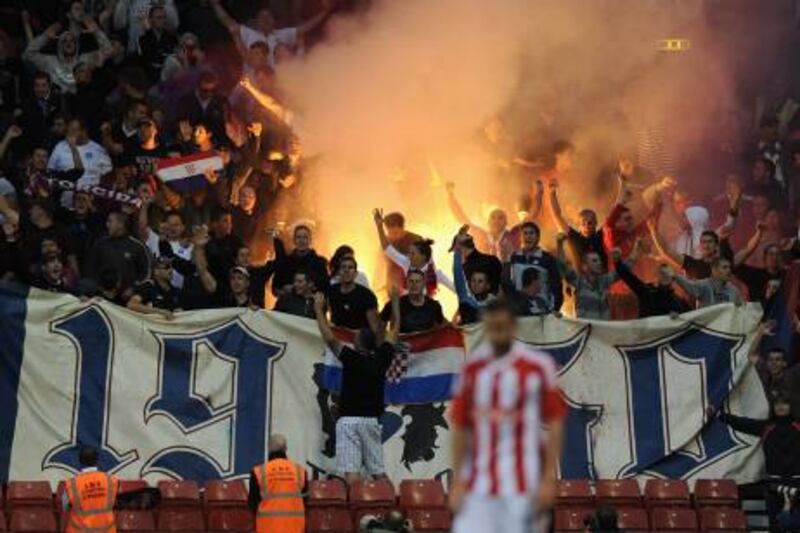How many times, in the lead up to matches at Stoke City, do you see players from more vaunted teams visiting that part of the English midlands, shake their heads and utter something along the lines of "Stoke is always a hard place to go"?
The phrase "Fortress Britannia" has become a cliche since Stoke rejoined the top flight of English football.
In Spain, the words "Fortin Mestalla" are similarly uttered. Valencia's steep grandstands, and the raucous atmosphere that the supporters can create on a full night, make the old ground – where the Primera Liga's third-placed team are still the tenants because financial problems halted work on a new, modern arena – seem genuinely intimidating.
So, if you believe the propaganda, on Thursday night Valencia will have a taste of their own medicine, as guests of Stoke City in the Europa League. Believe the hype and this will be a tie decided, over two legs, in favour of whoever registers the higher margin of victory in their home match.
But is the Britannia Stadium really such a fortress? Or is it a myth? Certainly, Stoke's three and a half years in the Premier League have witnessed some stirring afternoons and evenings at the ground.
Arsenal have been beaten there twice in three trips, but the record against other English clubs who tend to aspire to titles is fairly unremarkable.
Yes, Liverpool have learned to feel twitchy about going to Stoke, having collected only two points from their last four league journeys there. But Chelsea have not. Their record over the same period is two wins and two draws at the Britannia.
Tottenham Hotspur have won there twice, and suffered two defeats. Manchester City have taken five points from three away fixtures there. Manchester United usually win, having failed to collect maximum points just once – they drew – in four expeditions across the drawbridge of the so-called fortress.
The overall statistics are hardly conclusive either. If the Premier League table were drawn up simply on home results, Stoke would be 13th.
The actual table at the moment? Stoke sit … 13th. Their home record going into Thursday night? Two points from their last four matches at the Britannia.
As for the Mestalla, here the scrutiny of statistics also chips away at the fortress walls.
Valencia are currently in what has become their customary Primera Liga position, behind the two giants, Barcelona and Real Madrid. They finished third in the last two campaigns.
But home form alone in those seasons would have made them the sixth, and then the third, most effective hosts in the division.
Still, recollections such as seeing the Real of the galactico era – David Beckham, Zinedine Zidane, Ronaldo and company – sneak into the Mestalla via a back entrance contribute to the catalogue of anecdotes around Fortin Valencia.
Players genuinely talk about the decibel levels there being notably high, the same way European visitors to Liverpool, above all, talk about Anfield's aura and about how Celtic Park in Glasgow can genuinely make a man cower.
And Celtic's home record in Europe is genuinely strong.
In international club football, you would logically expect the home factor to count for more. The distances the visitors have travelled will normally have been greater; the experience of a foreign stadium is more likely to be new; the contingent of helpful away fans will probably be smaller, because of the cost of the trip, than in domestic competition.
But that logic does not always hold. With more and more European football on the calendar, away travel among the elite seems to have become much less daunting. Fortresses are scaled far more readily than they used to be.
When, for instance, the European Cup first introduced the away goals rule for knockout ties in the mid-1960s, it recognised how much tougher it was to score away from home.
On average, away wins in the European Cup between 1967 and 1972 accounted for only 16 per cent of results. Now they are twice as likely.
In the Champions League group phase around a third of results, typically, are away wins.
During the 2008/09 group stage of the Champions League, 31 per cent of matches were victories for the visiting side; in 2009/10 it was 35 per cent. Compare the leading domestic leagues: in the Premier League, in Spain's Primera Division and in Italy's Serie A, the portion of overall results that were away wins 2009/10 was around 24 per cent in each.
Tactical developments provide some explanation. Many teams travelling in Europe have over the last decade fine-tuned strategies of ambush, of one up front, of playing on the break.
"Successful teams now include the ability to counter-attack in their repertoire," said Andy Roxburgh, the technical director of Uefa, who run the Champions League, "and that's even sides with attacking traditions like Manchester United and Real Madrid."
Familiarity also plays a part. Where the European Cup of the 1960s and 1970s was exotic, with a greater range of destinations and opponents, the modern format tends to be more repetitive.
In recent years, Manchester United have played at Barcelona's Camp Nou almost as often as they have at the Britannia.
By the later stages of European competitions, a medium-haul trip is a freak event, and will probably only ever involve a Russian, Ukrainian or maybe a Turkish destination.
As for stadiums, Uefa's guidelines on arenas and pitches get stricter and stricter, so the very environment in which home and away games are played becomes homogenised.
Then there is the "prawn sandwich" principle, as Roy Keane, the former captain of Manchester United, memorably observed: crowds at the costlier midweek evening games do tend to be quieter, more corporate – as they dine on seafood canapes in their executive boxes.
There may even be some on the menu at the Britannia this evening.
Happily, European nights are still a novelty there, not events taken for granted. Valencia will not be greeted by a hush.
The toughest trips in Europe
Ali Semi Yen, Istanbul
Galatasaray fans would greet visiting teams to their old Istanbul home with banners, in whatever language the guests spoke, that said “Welcome to Hell”. A special gesture was also directed by some supporters at away team players whose eye they tried to catch: the motion of running a finger across the throat, menacingly, as if it were a knife.
Celtic Park, Glasgow
Veterans of some of the greatest derbies in the world commonly describe Glasgow’s as the most intense. But it is not just when Rangers come across town that Celtic fans raise the roof. Celtic’s home record in the Champions League is impressive, just as their modern away record in Europe is very poor.
San Paolo, Naples
Napoli’s return to the European Cup after an absence of two decades is still going strong – they host Chelsea in the Champions League next week – thanks largely to their stirring home form in front of Italy’s self-styled “most passionate” fans. The former playing idol Diego Maradona’s image is ubiquitous.
Westfalen Stadium, Dortmund
Now goes by the rather clumsy title, Signal Iduna Park, but its character has not changed with sponsorship. Standing is allowed at one end in Bundesliga matches, and when standing becomes jumping, that grandstand turns into a vast yellow jelly. Dortmund let in only eight goals at home all season on the way to their 2011 league title.
Old Trafford, Manchester
Often derided for its supposedly understated atmosphere for midweek European matches, the so-called Theatre of Dreams is actually one of the hardest places to visit. United’s 12 successive home wins, achieved with a semi-final victory over Barcelona in 2008, is a Champions League record.






